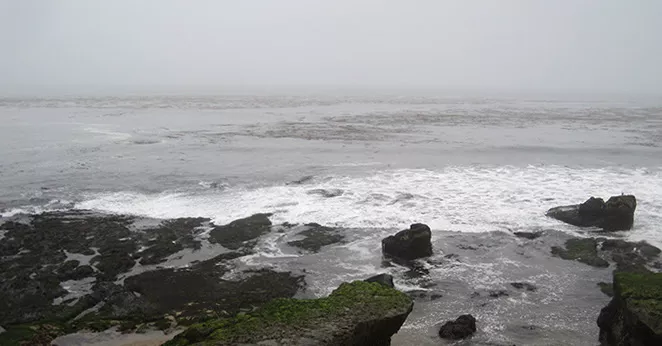The renowned author and satirist Mark Twain once said, “The coldest winter I ever spent was a summer in San Francisco.” He was, of course, referring to the City's coastal fog. So what is fog? A basic definition of fog is "a cloud in direct contact with the ground or water.” There are a number of different kinds of fog, but the most common to our region is advection fog which forms along the coast.
In the summertime, the marine fog that occurs along coastal areas with climates similar to California’s—Chile, Peru, South Africa, and the Canary Islands—is a result of complex air, land, and sea interactions along the eastern edge of ocean basins. (The Monterey Bay is situated at the eastern edge of the northwest-to-southeast-trending California Current, the northern of which maintains a very chilly average temperature of around 55 degrees.)
Fog’s microscopic water droplets form when they encounter a microscopic airborne particle (such as salt or other ion, molecule, dust, pollen, metabolically-active bacteria, protozoan, fungus, or biogenic fragments produced or brought about by living organisms), known as a cloud condensation nucleus.
As warm air stirs up the waters of the Monterey Bay, and at the same time summertime temperatures rise in deep, adjacent valleys, the largest of which are the Salinas and Santa Clara. As warm air travels southeasterly hot air rises and moisture-laden air is drawn landward from the Current to fill the void.
When the fog comes ashore its movement is at the mercy of hot valleys and landforms. In the Monterey Bay region the most powerful rising column of warm air is over the Salinas Valley.But as the fresh fog moves down the length of the Salinas valley it encounters the bottom of the Santa Clara Valley, where warm air is also rising. Part of the fog layer pulls off the main bank and turns north, in diametric opposition to the mass that moves deeper into the Salinas Valley. Subsequently, as this portion of fog moves northerly—where it will eventually combine with fog moving southerly from the Golden Gate—it encounters the southern flank of the Santa Cruz Mountains and is deflected westerly over Watsonville, coalescing with a finger of fog that has been pulled up into the Pajaro Valley watershed. Finally the links are made and we settle into the gray reality of our living here.

Coastal fog at Rockview, Mid-County. PHOTO COURTESY OF MIKE GUTH
And whereas the fog might make your day at the beach unpleasant, it is essential for the growth and sustenance of much of the vegetation in our region, and especially the Redwood tree,whose needles are uniquely shaped for the collection of the airborne moisture fog brings with it.
If you’d like more information on fog, check out the Coastal Fog Project, from which much of this information was drawn. It is a production of the United States Geological Service (USGS) online HERE.
You can also learn how to forecast the likelihood of fog by reading Jeff Haby’s list of characteristics HERE.
Contemporary Turkish playwright Mehmet Murat Ildan once wrote, “When you are happy, you feel the sunshine even inside the fog; when you are unhappy, you feel the fog even in the sunshine.” Be happy and learn to accept this essential part of coastal living.